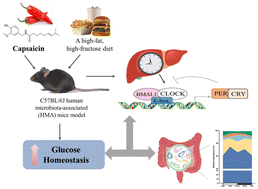Capsaicin ameliorates diet-induced disturbances of glucose homeostasis and gut microbiota in mice associated with the circadian clock†
Abstract
Glucose metabolism disorder triggered by a high-energy diet is associated with circadian disruption in the brain, peripheral tissues and gut microbiota. The present study aims to investigate the regulating effects of capsaicin (CAP) on the diet-induced disturbances of glucose homeostasis and gut microbiota in respect of circadian rhythm-related mechanisms. Our results indicated that CAP significantly ameliorated glucose metabolism disorder in mice induced by a high-fat and high-fructose diet (HFFD). The rhythmic expressions of circadian clock genes (Bmal1, Clock, and others) and glucose metabolism-related genes (Pgc-1α, Glut2, G6pc, and Pepck) in the liver disrupted by an abnormal diet were also recovered by CAP. Microbial studies using 16S rDNA sequencing revealed that CAP modulated the structure and composition of gut microbiota and improved the circadian oscillations of Firmicutes and Bacteroidetes at the phylum level and Allobaculum, Bacteroides, Bifidobacterium, and Alistipes at the genus level. Correlation analysis indicated that a close correlation existed between intestinal microbiota, hepatic circadian gene expressions and the level of glucose metabolism-related factors, indicating that CAP could alleviate HFFD-induced disturbances of glucose metabolism and gut microbiota associated with circadian clock related mechanisms.



 Please wait while we load your content...
Please wait while we load your content...